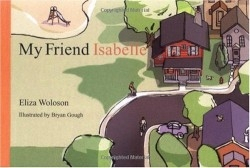My Friend Isabelle
First friendships are more than sweet; they set the tone for a lifetime of relationships. Early friendships offer children a safe forum to practice their budding social skills. It’s wonderful for anyone, whether four or forty, to be with another person who shares their toys, their cereal, and their love.
In this charming tale, with only a sentence or two per page, the author lovingly shows the tender friendship between her daughter Isabelle and her friend Charlie. Like most friends, they enjoy each other’s company. On their weekly play date they eat snacks, go to the park, and play together. They are very much alike.
Though the same age, they are also different-one is fast, the other slow; one is tall, the other short. The biggest difference between them is that Isabelle has Down syndrome.
The author, who has daughters named Isabelle and Audrey, established the Global Education Fund, a nonprofit organization that builds libraries in orphanages around the world. This is her first book, and in it she never tells the reader directly that Isabelle has Down syndrome. Parents learn this fact from the back cover. The author gracefully shows that everyone is different and that differences are not impediments to forming friendships. Rather, Woloson’s message is that differences are what makes friendships interesting.
From Charlie’s perspective, and hopefully the readers’ as well, Isabelle is not defined by Down syndrome-it is just part of who she is, along with being a good friend to Charlie. The author explains her wish for parents and educators to use this book to facilitate discussions about differences. On the inside of the back cover, Woloson writes a note to parents: “Through their friendship, Charlie and Isabelle are doing their small part in making the world a more tolerant place.”
The illustrator is a designer and artist living in Boulder, Colorado, and raising his son, John. His gentle illustrations complement Woloson’s sparse text. Soft sweeps of color are given shape with pencil outlines, presenting both children with a realistic whimsy. Though the pictures look very simple, they contain movement and expression.
Nearly every classroom in America has a child with some kind of special need or learning disability. If young children read books like these in preschool and kindergarten, perhaps the world would be as Charlie says: “more fun with friends like Isabelle.”
Reviewed by
Anna Stewart
Disclosure: This article is not an endorsement, but a review. The publisher of this book provided free copies of the book to have their book reviewed by a professional reviewer. No fee was paid by the publisher for this review. Foreword Reviews only recommends books that we love. Foreword Magazine, Inc. is disclosing this in accordance with the Federal Trade Commission’s 16 CFR, Part 255.

